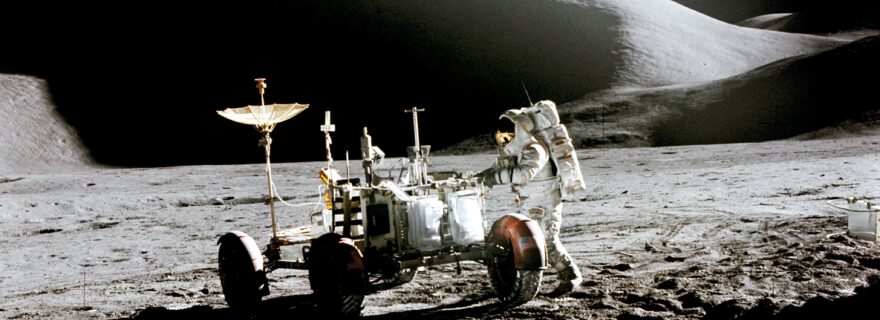Outer space heritage site protection
Missions to and around the Moon are about to burgeon. How to ensure that future space explorers, while making new histories, also undertake appropriate measures to protect sites with historic value?
Heritage protection in the context of US and US-led space missions
On 25 October 2022, the Office of Technology, Policy, and Strategy (OTPS) of NASA published a new Lunar Landing and Operations Policy Analysis (OTPS Report). According to this Report, at least 22 lunar surface missions are planned between now and 2026, half of which will be carried out at or near the Moon’s south pole. This could lead to the potential proximity of these operations and thus raise challenges.
One challenge identified in the OTPS Report is the need for heritage protection, and the Report recommends that NASA continues the implementation of its 2011 Recommendations on the protection and preservation of US lunar artifacts. While this document does not represent mandatory requirements, the US One Small Step Act adopted in 2020 directs NASA to add the 2011 Recommendations and any subsequent similar recommendations as a condition or requirement to contracts or other arrangements pertaining to lunar activities involving NASA.
At the multilateral level, the issue of human heritage protection in the context of planetary exploration is explicitly addressed in the Artemis Accords, which set out a general principle that the signatories intend to preserve outer space heritage considered as comprising historically significant sites and artifacts as well as to contribute to the development of international practices and rules on this matter.
Need for international agreements on heritage protection
Besides the US-led Artemis Programme, China is also advancing rapidly in lunar exploration with the achievements made in its Chang’e missions. China also signed a Memorandum of Understanding with Russia in 2021 regarding cooperation for the construction of the International Lunar Research Station (ILRS). As pointed out by Tanja Masson-Zwaan, there are currently two groups of States planning new lunar missions, one led by the US and one led by China and Russia, which makes good agreements important.
As noted in the OTPS Report, heritage protection may raise concerns over de facto ‘appropriation of outer space’. Since heritage sites will be indefinitely protected, the Report recommends that NASA ‘exercise[s] restraint in seeking heritage protection for future sites’. The Report also states that if the US requests protection for its heritage sites, it should also be willing to protect those of others, and an internationally agreed process for heritage identification and protection would provide many benefits in this regard.
Development of a legal framework for heritage protection
According to the OTPS Report, the protection of heritage sites requires at least a two-step approach: (1) identification of the sites to be protected; and (2) development and implementation of protection measures. Lessons can be learned from heritage protection regimes on Earth, with appropriate adaptions made. The World Heritage Convention adopted by the General Conference of the United Nations Educational, Scientific and Cultural Organization (UNESCO) in 1972 is particularly relevant to heritage protection. This Convention cannot be applied to outer space because it relies upon States to identify and delineate heritage sites within their territories, while outer space is not subject to the appropriation of any State under Article II of the Outer Space Treaty. Yet, the Convention provides interesting parallels for heritage protection in outer space, such as the duty of the international community as a whole to cooperate in heritage protection.
An analogy can also be drawn from the Convention on the Protection of the Underwater Cultural Heritage adopted on 2 November 2001 at the 31st General Conference of UNESCO, which urges States to take all appropriate measures to protect underwater cultural heritage. Another legal regime that could provide inspiration is Annex V of the Antarctic Environment Protocol, which sets out rules for the listing and protection of ‘sites and monuments of recognised historic value’.
Reference could further be made to the Building Blocks for the Development of an International Framework on Space Resource Activities adopted by The Hague International Space Resources Governance Working Group on 12 November 2019, as well as the Best Practices for Sustainable Lunar Activities published by the Moon Village Association (MVA) in 2020. Both instruments contain suggestions for the protection of natural and heritage sites.
For future normative development, physical differences between celestial bodies are factors to be taken into account. For instance, according to a Forbes article, the (non-)existence of atmosphere can have an impact on the natural preservation of heritage sites. Reference could be made to the Planetary Protection Policy of the Committee on Space Research (COSPAR), which classifies five categories of space missions based on a combination of the mission type and the interest of the target celestial body for understanding the process of chemical evolution and origin of life. The Policy was last updated in June 2021, adding two sub-categories of Category II for lunar surface missions according to their locations. Similarly, the type of mission and the characteristics of the celestial body could be elements for consideration in heritage protection.
As noted by Michelle Hanlon, the preservation of heritage sites would not only ‘help to maintain an accurate historical record for generations to come’, but ‘there’s a much more emotional aspect of it as well’. Since this issue is not specifically regulated under the Outer Space Treaty, States should come to an agreement that ensures compatibility between the designation and protection of heritage sites and the legal principles of free access to all areas of celestial bodies and of non-appropriation of outer space under current international space law.
Photo: Courtesy NASA



0 Comments
Add a comment